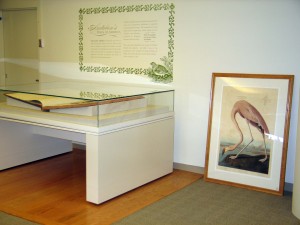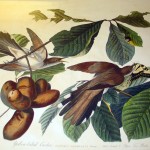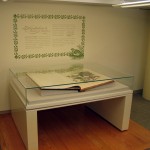 One of the first things I learned upon starting at the Watkinson was that our copy of the Birds of America, which was given to Trinity by one of its early graduates in 1900 (Dr. Gurdon Russell, Class of 1834), was incomplete. Unfortunately, well before the current security measures were put in place, a professional thief had stolen two plates from the book in 1977. One plate (no. 430, the Slender-billed Guillemot) was recovered from a Boston bookseller within a year of the theft—the man also stole from the Connecticut State Library, the Boston Public Library, the Peabody Institute, and the New Bedford Public Library in Massachusetts. The other plate (431, the American Flamingo), was never recovered. Fortunately, we were able to secure a copy of this plate (from another set, owned by a paper company in Alabama) at auction on September 28, so after 35 years, our set is complete again.
One of the first things I learned upon starting at the Watkinson was that our copy of the Birds of America, which was given to Trinity by one of its early graduates in 1900 (Dr. Gurdon Russell, Class of 1834), was incomplete. Unfortunately, well before the current security measures were put in place, a professional thief had stolen two plates from the book in 1977. One plate (no. 430, the Slender-billed Guillemot) was recovered from a Boston bookseller within a year of the theft—the man also stole from the Connecticut State Library, the Boston Public Library, the Peabody Institute, and the New Bedford Public Library in Massachusetts. The other plate (431, the American Flamingo), was never recovered. Fortunately, we were able to secure a copy of this plate (from another set, owned by a paper company in Alabama) at auction on September 28, so after 35 years, our set is complete again.
The fact remains, however, that somewhere out there, on someone’s wall (hopefully unbeknownst to them), is our copy of the Flamingo. Maybe someday we’ll find our wayward bird, but in the meantime, we will cherish our adopted one.
Tags: Exhibitions, natural history, New Acquisition, ornithology
Comments Off on Flamingo comes home!
 Actually, it’s the Yellow-billed Cuckoo–but in any case, the Audubon is now “in situ” and open to Volume I Plate II — ready for viewing! We will turn the page each Monday (or Tuesday, if Monday is a holiday) for the next 8.5 years and enjoy 433 new birds (Plate I, the turkey, was on display all summer, and so has done its duty; in fact, given the approach of Thanksgiving, we think it wants to keep a low profile).
Actually, it’s the Yellow-billed Cuckoo–but in any case, the Audubon is now “in situ” and open to Volume I Plate II — ready for viewing! We will turn the page each Monday (or Tuesday, if Monday is a holiday) for the next 8.5 years and enjoy 433 new birds (Plate I, the turkey, was on display all summer, and so has done its duty; in fact, given the approach of Thanksgiving, we think it wants to keep a low profile).
This plate (along with the other first five) was engraved by William Lizars in January 1827.
The choice of the first five plates was intentional, and the sequence was planned by Audubon during his tour of the Great Lakes in 1824. They included images of one large (turkey), one medium (Canada warbler) and three smaller species (yellow-billed cuckoos, purple finches, and prothonotary warblers).
Fifty copies were “struck off” for coloring, and Audubon was able to present the first set of five plates to the Royal Society of Edinburgh on February 5, 1827, with the venerable Sir Walter Scott in attendance. Audubon was scrambling to gather subscriptions to pay for the work.
 This exhibition is now open, but a more formal opening will be held on Thursday November 3rd. Prof. Christoph Irmscher from Indiana University (his faculty profile is here) will deliver a lecture entitled “How To Read Audubon.” Dr. Irmscher edited the Library of America edition of Audubon’s works, and writes on nineteenth-century American and Canadian literature, early American nature writing, and ecocriticism.From 4:00 – 5:00pm we will have all four volumes on display in the Reading Room, with Dr. Irmscher and myself on hand to answer questions. At 5:00pm professor Irmscher will deliver his talk in the Joslin Family 1823 Room, and we will hold a reception.
This exhibition is now open, but a more formal opening will be held on Thursday November 3rd. Prof. Christoph Irmscher from Indiana University (his faculty profile is here) will deliver a lecture entitled “How To Read Audubon.” Dr. Irmscher edited the Library of America edition of Audubon’s works, and writes on nineteenth-century American and Canadian literature, early American nature writing, and ecocriticism.From 4:00 – 5:00pm we will have all four volumes on display in the Reading Room, with Dr. Irmscher and myself on hand to answer questions. At 5:00pm professor Irmscher will deliver his talk in the Joslin Family 1823 Room, and we will hold a reception.
Tags: Exhibitions, ornithology
Comments Off on The Eagle Has Landed
 Here is a sweet little item we acquired last week–the only other copies I can find are at Yale and the British Library.
Here is a sweet little item we acquired last week–the only other copies I can find are at Yale and the British Library.
Songbooks like this are truly ephemeral pieces of popular culture, and in the mass are invaluable for the windows to the mores of their times. We have hundreds of songbooks, both religious and secular, as well as over 25,000 pieces of sheet music in the Watkinson–see our guide here: http://library.trincoll.edu/research/watk/documents/watkguidesmusic.pdf
Of particular interest in this collection to me personally are numbers 12 & 15. Number 12, “Negro boy sold for a watch” is a 24-line guilty lamentation of a person who sold a boy into the Atlantic slave trade for “this poor simple toy.” Number 15, “Sailor’s Farewell,” is a sailor talking to potential sweethearts about his actions during the Anglo-Egyptian War of 1807.
Tags: New Acquisition, ornithology
Comments Off on Greatest Hits of the 1820s
 Today our carpenters took apart the shelving where the new Audubon case is to be installed and un-crated the case. We won’t take the case off the pallet until the wall is painted, so there’s still a bit of “under construction” feel to the Reading Room. I figure we should be allowed at least as much slack as the Connecticut D.O.T.–and the Watkinson is so much more pleasant than Rte. 95!
Today our carpenters took apart the shelving where the new Audubon case is to be installed and un-crated the case. We won’t take the case off the pallet until the wall is painted, so there’s still a bit of “under construction” feel to the Reading Room. I figure we should be allowed at least as much slack as the Connecticut D.O.T.–and the Watkinson is so much more pleasant than Rte. 95!
 The excellent feature of this particular piece of equipment is that one person can open the case, slide the bed out, turn the page, and slide the bed in, without any stress on the book or the human. The glass is supported by gas struts, which raise automatically when it is unlocked.
The excellent feature of this particular piece of equipment is that one person can open the case, slide the bed out, turn the page, and slide the bed in, without any stress on the book or the human. The glass is supported by gas struts, which raise automatically when it is unlocked.
Tags: Exhibitions, ornithology
Comments Off on Audubon case revealed!
 The Watkinson received a VERY large package yesterday morning. Shown here in its crate, in which it was shipped from Germany, is a new display case for our copy of John James Audubon’s double-elephant folio Birds of America.
The Watkinson received a VERY large package yesterday morning. Shown here in its crate, in which it was shipped from Germany, is a new display case for our copy of John James Audubon’s double-elephant folio Birds of America.
Trinity’s copy was a bequest from alumnus Dr. Gurdon Russell (1815-1909) in May of 1909, and it is apparently the copy that Robert Havell (the engraver) owned. Havell is said to have selected every plate himself for this copy. Russell bought the set in 1882 for $1,150. The last set sold was knocked down at Sotheby’s (London) on December 6, 2010, and broke the record for the sale of any printed book–$11.5 million. A pinnacle of art, science, and book making, it is the most valuable printed book in the world.
The case will be placed near the wall behind it (after we remove the bookshelves), and we will work with a designer to create a permanent exhibition with information on the wall about Audubon, his book, and our copy’s provenance, which will be finished by August.
Tags: Events, ornithology
Comments Off on A big book needs a big case
 Gabriele Falloppio (1523-1562) & Volker Coiter (1534-1576). Lectiones de partibus similaribus humani corporis, ex diversis (Nuremberg, 1575).
Gabriele Falloppio (1523-1562) & Volker Coiter (1534-1576). Lectiones de partibus similaribus humani corporis, ex diversis (Nuremberg, 1575).
I acquired this from an antiquarian bookseller in New York, and at some point before that firm owned the book, it was on the shelves of the Library of the Medical and Chirurgical Faculty of Maryland (what is now the Maryland State Medical Society–for its history, see here: http://www.medchi.org/about-medchi/history).
This is a scarce edition of a series of anatomical lectures by Falloppio in their first published appearance, including two tracts by Coiter on the osteology of quadrupeds and birds, illustrated with 5 large engraved plates of mammal, reptile, amphibian and bird skeletons after Coiter’s own drawings. Two texts from the present work are of particular interest for the history of anatomical science: “Coiter’s study of the skeleton of the foetus and of a child six months old, [which] was the first study of developmental osteology and showed where ossification begins” (Garrison & Morton), as well as the treatise “De avium sceletis et praecipuis musculis,” which includes in table form the first classification of birds by species. The five large plates of animal skeletons that conclude the volume were apparently inspired by the Italian naturalist Aldrovandi. “Coiter’s illustrations,” says one authority, “most of which he etched himself, are far superior in quality to the zoological illustrations of Aldrovandi, and they occupy a prominent position in the history of zoology and comparative anatomy.”

Tags: History of Science, natural history, New Acquisition, ornithology
Comments Off on 16thC Latin treatise on anatomy (new acquisition)
 Actually, it’s the Yellow-billed Cuckoo–but in any case, the Audubon is now “in situ” and open to Volume I Plate II — ready for viewing! We will turn the page each Monday (or Tuesday, if Monday is a holiday) for the next 8.5 years and enjoy 433 new birds (Plate I, the turkey, was on display all summer, and so has done its duty; in fact, given the approach of Thanksgiving, we think it wants to keep a low profile).
Actually, it’s the Yellow-billed Cuckoo–but in any case, the Audubon is now “in situ” and open to Volume I Plate II — ready for viewing! We will turn the page each Monday (or Tuesday, if Monday is a holiday) for the next 8.5 years and enjoy 433 new birds (Plate I, the turkey, was on display all summer, and so has done its duty; in fact, given the approach of Thanksgiving, we think it wants to keep a low profile). This exhibition is now open, but a more formal opening will be held on Thursday November 3rd. Prof. Christoph Irmscher from Indiana University (his faculty profile is here) will deliver a lecture entitled “How To Read Audubon.” Dr. Irmscher edited the Library of America edition of Audubon’s works, and writes on nineteenth-century American and Canadian literature, early American nature writing, and ecocriticism.From 4:00 – 5:00pm we will have all four volumes on display in the Reading Room, with Dr. Irmscher and myself on hand to answer questions. At 5:00pm professor Irmscher will deliver his talk in the Joslin Family 1823 Room, and we will hold a reception.
This exhibition is now open, but a more formal opening will be held on Thursday November 3rd. Prof. Christoph Irmscher from Indiana University (his faculty profile is here) will deliver a lecture entitled “How To Read Audubon.” Dr. Irmscher edited the Library of America edition of Audubon’s works, and writes on nineteenth-century American and Canadian literature, early American nature writing, and ecocriticism.From 4:00 – 5:00pm we will have all four volumes on display in the Reading Room, with Dr. Irmscher and myself on hand to answer questions. At 5:00pm professor Irmscher will deliver his talk in the Joslin Family 1823 Room, and we will hold a reception.





